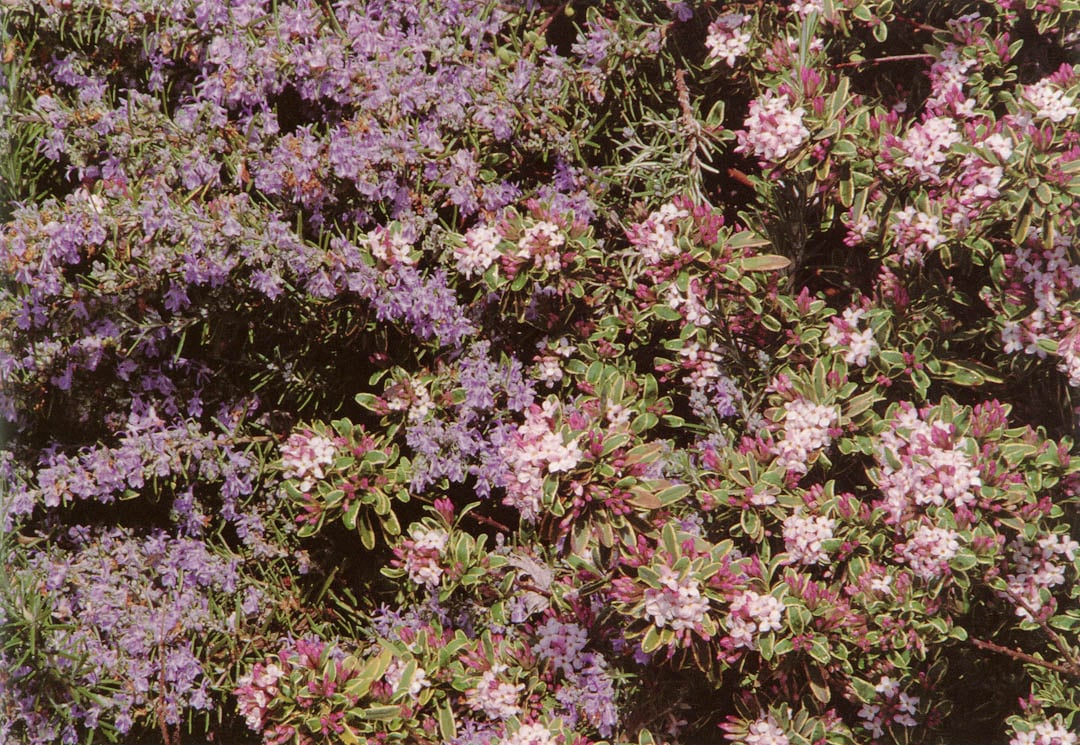

Contributor
- Topics: Archive, Plants You Need

The first leaves are falling gently outside my living room window, and my Japanese maples have begun their annual transformation to the brilliant colors of fall. I am always somewhat melancholy at this time of year, even though the fall foliage heralds a period of rest before spring’s riot of color tries to wear me out again. As I gaze out the window, my eyes travel over the side garden where a few valiant perennial plants hold fast to their prior glory. One of the California fuchsias (Zauschneria californica ‘Etteri’)—always the last to say “die”—still blows bright persimmon trumpets over shy Iberis ‘Autumn Snow’ with its little white snowballs artfully arranged on deep green leaves. Most of the shrubs have already given up the last vestiges of their foliage and stand, unclothed and barren, awaiting their new spring garments.
[sidebar]
Daphne x burkwoodii ‘Carol Mackie’
According to CD Brickell and B Mathew, authors of Daphne: In 1931 the Burkwood brothers (Albert and Arthur), of Great Britain, crossed Daphne cneorum and D. caucasica to create the D. x burkwoodii seedling stock. ‘Carol Mackie’ is a cultivar which appeared as a branch sport on a ten-year-old plant of D. x burkwoodii at the home of Mrs Carol Mackie in Far Hills, New Jersey. It has proven to be an extremely vigorous clone, notable for the clearly pronounced gold band around the edge of the leaf, and shows no signs of reversion to the solid green leaf of the mother plant.
From Rock Garden Plants: A Color Encyclopedia, by Baldassare Mineo, we learn that this daphne is a “semi-evergreen shrub for sun or part shade in fertile, well-drained soil,” preferably neutral to alkaline, and is well-adapted to USDA zones 4 to 8. Sunset’s Western Garden Book recommends it for zones 3 to 6 and 14 to 17, noting that it needs little water once established.
[/sidebar]
All, that is, except my beautiful Daphne x burkwoodii ‘Carol Mackie’, still elegantly gowned in her deep forest-green leaves trimmed perfectly in creamy-gold margins that brighten each leaf like a gold necklace on a dark cashmere sweater. ‘Carol’ is chic year-round. In spring she adorns herself with the palest of pastel pink flowers with an unmistakable sweet scent that turns everyone’s head. When her flowers are gone, she is still a beautiful color counterpoint in the garden (although occasionally upstaged by her cousin, Daphne caucasica, who flowers almost non-stop). Standing there at her full three-foot height (and width, if that’s polite to discuss) she is truly the queen of her garden, reigning with majesty and charm. Yet she is also considerate of the “little people” as evidenced by the miniature ferns at her feet, relishing the shade that ‘Carol’ provides in summer. A delicate Cystopteris fragilis now peeks sleepily from under her skirts where it will be sheltered during winter dormancy.
As I close the curtains on my garden, I pause and take a moment to thank the Lord for creating all things, but especially for shrubs like this daphne that provide me with such comfort and joy on melancholy fall days.
Share:
Social Media
Garden Futurist Podcast
Most Popular
Videos
Topics
Related Posts

Low Maintenance Gardens – Better for Pollinators and People
Autumn 2022 “I come out every day. It’s therapy, my meditation.” Janet’s young garden transformed from overgrown, invasive plants to mostly natives. The dailiness of

Calochortophilia: A Californian’s Love Affair with a Genus
Summer 2022 I can chart the progression of my life by Calochortus. For the last two decades, at least. As a teenage girl growing up

Pacific Plant People: Carol Bornstein
Spring 2022 Public gardens play a key role in demonstrating naturalistic planting design, selecting native and adapted plants for habitat, and testing techniques for reducing

Add Year-Round Interest and Winter Blooms for Pollinators
Spring 2022 This article was created from an Interview by Merrill Jensen with Neil Bell in the Summer of 2021 for our Pacific Plant People









Responses